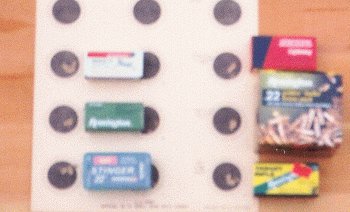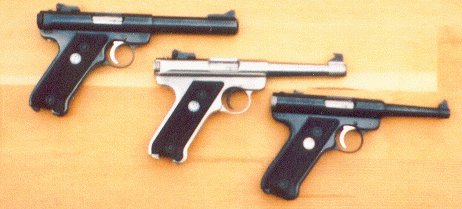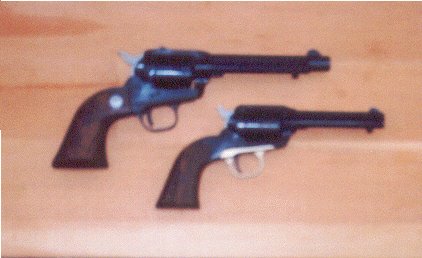
*Twenty Twos for Fun and Survival*
Twenty-two caliber rifles and handguns serve many purposes. They can be used for some hunting, limited defense, entertainment and most importantly training. Billions of .22LR rounds are loaded annually by the major ammunition manufacturers in a number of different loadings and most are unloaded by both kids and adults having fun, hunting or working on improving skills. Various loadings from hyper speed hollow points like Stingers or Yellow Jackets to the high speed Mini-Mags and standard velocity rounds in Long Rifle are the most used, but there are also Short, Long, shot loads, and loads without powder (CB caps, BB caps and Calibri). Some of the cheapest ammo is also some of the worst in terms of accuracy and reliability but at close range and for plinking fun, they can't be beat.

I have seen where people buy a nice .22lr rifle and then go down to the local bullet mart and buy a brick of the cheapest ammo they can find and take that to the range and shoot a few targets and then are disgusted with the "terrible accuracy" that the gun gave. I have learned over the years that especially with .22lr, the ammunition is "at least" as important to accurate shooting as the weapon and shooter are, maybe even more so. When I get a new .22 that I am especially seeking better accuracy from, I will go down to the local outfitter and stock up on one box of each of the brands and loadings that I can find (or am willing to spend for) target and bulk packaged, and take them to the range. There I will carefully shoot for accuracy ten 5-shot groups with each box, cleaning the bore between boxes. Then determine which is accurate enough, within the budgetary constraints I impose for the goals I have for that rifle or pistol and ammo, and only then stock up on the chosen loading.
When storing my ammo I find a good condition .50cal ammo can. I make sure the rubber seal is in good condition and the can seals up properly and the locking bail is not bent nor are the edges of the can bent or damaged. I also try to find a can that does not have a lot of rust inside or out. Then I will clean the can thoroughly and maybe paint it again with a good quality dull color tan, brown, olive green or black (taking care not to get any paint on the rubber gasket). Then stack the ammo in the can as efficiently as possible. With the standard 50 round cardboard box you can pack 5000 rounds in a .50 cal ammo can. Plastic trays that some ammo is packed in is not quite so efficient. Then after sealing the can up I store it in a cool (50-60degree F), dark out of the way place. I have some ammo that is 25 plus years old and shows no degradation in performance when stored like this.
I like the .22lr and have a number of rifles and pistols in this very versatile caliber. Pistols can be as finicky as rifles about ammunition loads and accuracy, but your training level and your accepted accuracy level are what drives your ammunition selection. Remember however, pistols or rifles shot under 25 yards for small game like rabbits or taking camp meat like Spruce Hens (which we call "stupid chickens" because you can get so close to them) don't really require extreme accuracy. I use the 22lr for training, hunting and foraging while hunting moose or out camping. I have found the CB and .22lr Calabri (no powder) to be almost silent from a rifle, yet they will take the head off a Spruce Hen or Grouse along side the trail and not scare other game in the area, however, they will not cycle a recoil operated semi-auto. Revolvers are not so finicky about whether you shoot short, long, long rifle or even the no powder types of ammo through them.
In my opinion the .22lr is a great survival gun for foraging, however, it is marginal for any kind of defense use, of course it is better than a sharp stick. A number of years ago I was visiting with the then head ballistician for the San Antonio police department (he worked with the prosecutors office as an expert on firearm and bullet evidence) and he told me at that time they get more "deaders" in for processing that were shot with the .22lr than anything else! Apparently people get mad and shove a .22lr or .25acp mouse gun in another person's face and pull the trigger a couple times then run. It is not a "one shot stopper" by any means but it does have potential. There are many trappers in Alaska that use a .22lr for dispatching everything they trap. We even have a few natives (the only ones that can get away with it apparently) that have used the .22lr to dispatch their caribou or moose with a single shot (close range brain shots only). The Israelis have even used the Ruger 10/22 semi-automatic rifle with an integrated silencer and scope to "remove" some rioters with sometimes deadly results. This is not to say that I would grab my trusty .22 when running to defend my home or family, but if that is all I had at hand I would use it within it's limitations.
As a training arm the decreased noise and recoil are conducive to helping anyone learn how to shoot or shoot better. I have used .22s to train my own kids and many adults in marksmanship skills without the sound or recoil of other more powerful and expensive firearms. Much of the .22lr I have stored was intended primarily for training, but then it has so many other uses too.

Ruger Standard MKII auto - I have found that the Ruger .22LR Semi-automatic pistols are accurate and very reliable over the long run. I have a few Mark II Standard and Target model pistols. While in the Army I trained a couple military pistol teams with the Ruger .22LR Semi-automatic "Government Model" that uses a 6 7/8" long bull barrel. The MkII pistols use the newer 10 round magazines with the bolt hold open feature on the last shot (the older MkI or Standard, 9 shot magazines will not work and do not support the bolt hold open feature). One other important tidbit is that the MkII Ruger Pistol uses the same extractor and extractor spring as the Ruger 10/22, simplifying some spare parts purchases and storage (check Brownells' or Midway's catalog for parts kits).
Ruger initially designed this handy pistol to be cheaper to produce than the Smith & Wesson, Colt Woodsman, and High Standard pistols of the day. Hoping to capitalize on the large number of people post WWII that wanted a .22 pistol but could not afford the fancier grade guns. When first produced they were sold for about $47.00, which was much below the other "high grade" guns. With a good gun and a great price people flocked to buy the new auto, and Ruger began his fortune.
I personally like the heavier 5" bull barrel to the shorter barrel lengths, the 4 3/4 inch is light in the barrel and the 7" is too long but balances better. I have changed the front sight on my 5" bull barrel to a ramp to help both in drawing and shooting. I don't feel the partridge style sight is needed in what I do with the gun and besides the partridge sight has the potential to hang up on flesh and clothing when drawing, but I do like the adjustable sights. Depending on skill level or availability of special sights, these guns will shoot out to 50 plus yards with amazing results. One and a half inch to two inch groups are not unusual, with training, a rest and judicious ammunition selection.

Marlin Papoose - A few years ago I bought a Marlin Papoose take-down rifle. It is a stainless steel model that comes with a cloth case and single 7 round magazine and a compact barrel wrench tool. I purchased some spare magazines (both 10 round and 7 round) to include in my kit. The Papoose has a positive bolt hold open after the last shot feature that I like. It seems very accurate and can be packed in my ruck taking up very little space. I have alternated between a Ruger MkII pistol or the Papoose in my pack with a couple boxes of both hollow point and solids for taking camp meat. I have never regretted the weight. They are acceptably accurate and quick to bring to the shoulder for taking small game at short range to 50 yards.
The rifle is easy to take down: First take out the magazine and make sure it is empty, then loosen the barrel nut and remove the barrel. If you use the soft case it comes with (that is designed to float with the gun enclosed), pack it up in that. I carry a small blanket in my pack and have rolled up the barrel and stock in it before to reduce weight and bulk a little. But have also bungie corded it to the outside of my pack in it's case. The case doesn't seal up very well so make sure that nothing falls out, or finish sewing the zipper around the case.
Every plane in Alaska is supposed to carry a survival kit that usually includes a firearm. One of these take-down models in stainless steel with a few boxes of ammo would fill the bill nicely. And even though it doesn't float (unless it is in it's case) it is easier to quickly engage a target than the Henry Survival Rifle.

Henry Survival Rifle - Production of the AR-7 rifle has been performed by a few different manufacturers over the years. Some examples have had feed problems and other issues that have rendered this rifle into little more than an anchor in many people's eyes (and it does not work well as an anchor because it floats). However, not being one to take another person's opinion totally, I recently bought a new Henry Survival Rifle in silver. My example included a spare 7 round magazine.
The rifle comes apart simply by - first ensure it is empty by removing the magazine, retract the bolt and inspect the chamber, then unscrew the barrel nut and pull the barrel forward out of the receiver. Then at the base of the pistol grip unscrew the thumbscrew and pull the receiver forward out of the stock. Then insert the barrel, receiver with magazine inserted into the stock (where a spare magazine is also stored) and slip the butt pad/cover onto the end. Assembly is in the reverse.
Taking the rifle to the range for fun and of course testing, I found it shot very well. I did find the stock fat and just to bulky, I had some difficulty getting a good stock weld so that I could see the tiny aperture sight, but it did shoot very tight groups considering. I was able to get a couple sub 1" groups at 20 yards (which is great for me). I shot it with both standard and high velocity ammo and did not have any difficulty with the gun. I checked the chamber area and the usually sharp edge on the face of the chamber was rounded and not sharp at all.

Ruger 10/22 - The 10/22 is arguably the most reliable and useful .22lr rifle for what we have in mind here. It is extremely reliable, rugged and can be customized very easily if you so desire. Many add-on parts can be found on the internet or in catalogs like Midway and Brownells. If you want improved accuracy you can easily change the barrel to a bull-target type with a kit that includes stock and barrel. I like the option of a sling so have added sling swivel studs to most of our 10/22s and black nylon slings. Some add-on parts may be useful, however I have found that the basic rifle is still the most versatile, I have not tried to turn them into "mini assault rifles". The lower rifle in the above picture has an aftermarket aperature sight installed by the previous owner. The front sight is made of plastic, sticks too far up and is less than useful. I am in the process of getting a replacement factory front sight to fix it.
I have given a 10/22 to each of my kids. These are robust and reliable rifles. The 10 round "cube" magazine is handy and very reliable, I recommend you get at least five magazines for each rifle. I have tried a couple of aftermarket 15, 20 and 30 round magazines but none have worked for me. I have a habit of making sure a bad magazine does not stay in my inventory to be mistaken for a good one later. All of my aftermarket mags were crushed with a handy rock when they repeatedly jammed. I have never had to take a rock to a Ruger factory magazine to adjust it, yet;).

Remington 40X or other target rifles - While training with any .22lr is great as far as it goes, getting a target quality rifle (or pistol for that matter) will really improve your shooting ability. The best way to do so is to get a quality target level rifle and practice. The reason I say a target level gun is that you can shoot any gun at 50 or 100 yards and when you go look at the target you find a nice but not exceptional group. Well was that group the best that the gun was capable of, or can it do better. Can you as a shooter do better, or was that your best target engagement ever, how can you know? If you have a gun that will shoot one hole groups at 50yards or 1/4 inch groups at 100, then you would know quickly that you needed more practice or what.
There are accessory barrels for the Ruger 10/22 along with trigger/spring parts kits that will turn the average 3-4" at 100 yard rifle into a real tack driver. One of my shooting buds did this recently and his rifle displayed a major improvement in accuracy. Or you can pick up many older/used bolt action target guns at gun shows, gun shops or even at a yard sale for a pretty good price sometimes. Target guns don't normally get enough use to wear them out so good shooters can be found for a reasonable price. Use them to practice and really learn shooting skills.
I recently found a Remington 40X in .22lr at a yard sale with the original Redfield Olympic aperture sight. I have taken it out to the range and spent some time and a number of different boxes of ammo to find that Remington Rifle Target (blue box, standard velocity) shoots into one single 1/4 inch diameter raged hole while the Remington Golden Hollow Point (bulk packed 550 rounds of high speed) went into a slightly larger hole at 20 yards. This rifle weighs over 13 lbs and is only a single shot. I don't think I will use it to hunt bunnies. The trigger has no noticeable movement and breaks somewhere in the ounces with no over-travel. I am learning all over again how to shoot a rifle. And its just plain fun to make little holes!

A short note on revolvers: There are many quality .22 revolvers on the market. I have an old model Single Six with an interchangeable .22 mag cylinder and a very pristine original .22 Bearcat that was handed down to me from my Grandfather that I like. I have owned Smith & Wesson model 63 kit guns and other manufacturer's .22 revolvers, but always got rid of them for various reasons keeping the Rugers. I found many to be good accurate guns, however, I feel they are too slow to load and shoot and do not mimic the service pistols the way I want a training arm to. They are wonderful when you have scrounged ammo, or mix the loading of the cylinder with shorts, long and long rifle ammo. For a strict hunting gun I find them quite useful. However, for general purpose use I just prefer autos.
The short of my opinion is to get a .22lr to improve your skills, hunt small game or just to have fun with. I recommend that if you get a chance to shoot various examples do so extensively before you decide on one to buy. As for me and mine, we will continue to use what works for us. Any good .22 is worth the expense and may someday save your life, either through improved skills or as a tool for survival.
Tailgunner
All materials at this site not otherwise credited are Copyright © 1996 - 2002 Trip Williams. All rights reserved. May be reproduced for personal use only. Use of any material contained herein is subject to stated terms or written permission.